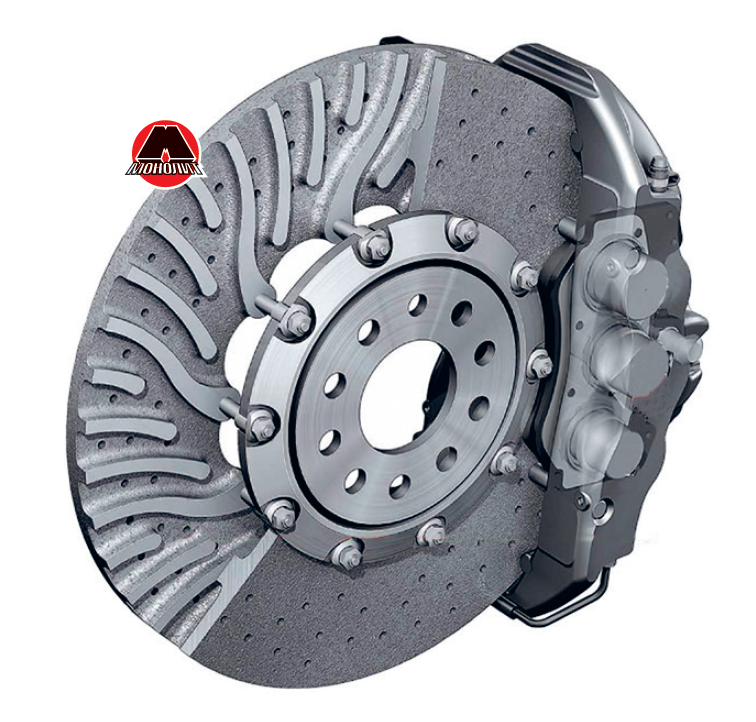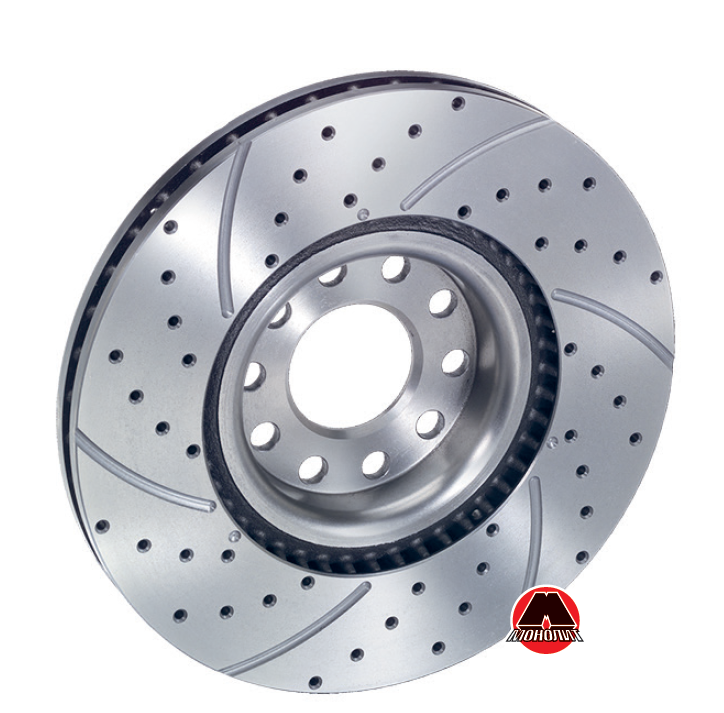7.2.7 Disc brakes
Disc brakes are the only promising alternative to drum mechanisms for passenger cars. In such mechanisms, the brake disc is attached to the wheel hub and rotates along with it. In order to stop the car, it is necessary to bring under pressure brake liquid to the piston in a brake support. The piston, while acting on the brake pads, will transmit to them the force of the brake fluid, press against the disc and start slowing down the wheel. The principle of operation of the disc brake is somewhat similar to a bicycle brake, where the surface of the wheel rim acts as a disc, and the stop is made by pressing the brake pads towards the rim. The arrangement of the disc braking mechanism can be seen in Figure 7.4.
 Figure 7.4 Example of disk braking mechanism.
Figure 7.4 Example of disk braking mechanism.
Note
There are two types of brake calipers: fixed and floating. In the first case, the brake caliper has two pistons that are located on either side of the brake disc. The caliper itself is rigidly attached to the steering knuckle. The pistons act on the inner and outer brake pads. Brake fluid is supplied to each of the pistons. In the second case, the brake caliper has a piston or pistons on one side only. It has the ability to move along the axis of rotation of the disk. Thus, while braking, the piston moves and presses on the inner pad. After that the pad rests on the disk, and the pressure in the hydraulic drive continues increasing. The caliper will begin to move and press the outer pad to the disk. The first option is stronger, but more expensive. The second option is cheaper, but not as reliable.
The efficiency of disc brakes is much higher than the efficiency of drum brakes. They are easier to maintain and better dissipate the heat, which is released during braking.
Designers decided to increase efficiency of heat removal from the brake mechanism, because overheating of brake mechanisms is considered as one of the most dangerous aspects. The way to solve the problem is simple in terms of ideas and not so simple on practice. Many holes and channels have been made in the disk, through which it is possible to pass air in order to cool the disk from the inside (Figure 7.5). Efficiency was increased many times. But everything has its price. And in this case they had to pay for low resistance to temperature changes in order to receive improved cooling. There is a possibility of appearance of cracks on the disc when, for example, water gets on it during very active braking. The reason is that these holes are stress concentrators. It turns out that the principle "It tears where it is thin" works.

Figure 7.5 Example of a ventilated brake disk.
Grooves can often be seen on the brake discs (Figure 7.6). The reason why the disc is manufactured with such design features lies in the fact that while performing braking a layer of waste material (dust) is created on the friction linings of the brake pads. This layer impairs the braking efficiency. The layer of the worked out dust is cut off by grooves, cleaning thereby a working surface of a frictional pad.

Figure 7.6 Example of a ventilated brake disk with special grooves.
But as time goes on, some cars become more powerful and heavier. They have high dynamic performance and very high power-to-weight ratio*. And the process of stopping all this mass, which is moving at great speed, requires the use of super-efficient braking mechanisms. The main indicator, which influences the efficiency of the brakes, as it was already mentioned above, is the temperature. There are two methods for solving the problem of brake overheating. The first method is to manufacture the brakes with their own cooling system. But this makes their design and subsequent maintenance too complicated. The second method is to install composite brake discs; such as disks of powder-metal type. Such disks are not affected by overheating at all. But the fee for disks of powder-metal type is their fragility and high cost.
Note
* Power-to-weight ratio is a specific indicator, which characterizes how many kilowatts or horsepower are per unit weight of a car (per kilogram or per ton). For example, in case if the car weighs 2 tons and its engine capacity is 300 hp, the power-to-weight ratio of this car is 150 hp/t. But a car weighing 1 ton and engine capacity of 150 hp will have the same power-to-weight ratio, and therefore will not be inferior in dynamic characteristics to a more powerful, but also heavier "rival".
Note
Disc brakes are often equipped with a friction pad wear sensor. In the simplest form, this sensor is a spring-loaded plate, which when the maximum thickness of the friction lining reaches the disk and starts creaking. In a more complicated version, this sensor in the literal sense of the word is installed. The readings of this sensor are displayed in the corresponding place on the instrument panel.



















2 MB